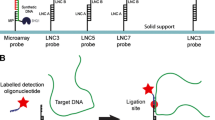Abstract
After the microbiology based on Pasteur’s method and polymerase chain reaction (PCR), the diagnosis company named Dendris has proposed a third-generation of diagnosis enabling the search of a broad range of pathogens with strong sensitivity and specificity. This extraordinary profile was possible thanks to the use of phosphorus dendrimers for which various techniques of deposition on a given support were investigated and described and analyzed in this report.
Similar content being viewed by others
References
He Z. Microarrays: Current Technology, Innovations, and Applications. Poole: Caister Academic Press, 2014
Jo H, Lee S, Ban C. Highly sensitive and selective in vitro diagnostics based on DNA probes and aptamers. Biodesign, 2015, 3: 33–40
Joos B, Kuster H, Cone R. Covalent attachment of hybridizable oligonucleotides to glass supports. Anal Biochem, 1997, 247: 96–101
Rogers YH, Jiang-Baucom P, Huang ZJ, et al. Immobilization of oligonucleotides onto a glass support via disulfide bonds: a method for preparation of DNA microarrays. Anal Biochem, 1999, 266: 23–30
Donatin E, Drancourt M. DNA microarrays for the diagnosis of infectious diseases. Médecine Maladies Infectieuses, 2012, 42: 453–459
Pillet S, Lardeux M, Dina J, et al. Comparative evaluation of six commercialized multiplex PCR kits for the diagnosis of respiratory infections. PLoS ONE, 2013, 8: e72174
Benters R, Niemeyer CM, Wöhrle D. Dendrimer-activated solid supports for nucleic acid and protein microarrays. ChemBioChem, 2001, 2: 686–694
Tomalia DA, Naylor AM, Goddard WA. Starburst dendrimers: molecular-level control of size, shape, surface chemistry, topology, and flexibility from atoms to macroscopic matter. Angew Chem Int Ed Engl, 1990, 29: 138–175
Park JW, Jung Y, Jung YH, Seo JS, Lee Y. Preparation of oligonucleotide arrays with high-density DNA deposition and high hybridization efficiency. Bull Korean Chem Soc, 2004, 25: 1667–1670
Benters R. DNA microarrays with PAMAM dendritic linker systems. Nucleic Acids Res, 2002, 30: 10e–10
Ahmed S, Vepuri SB, Kalhapure RS, et al. Interactions of den-drimers with biological drug targets: reality or mystery—a gap in drug delivery and development research. Biomater Sci, 2016, 4: 1032–1050
Svenson S. The dendrimer paradox—high medical expectations but poor clinical translation. Chem Soc Rev, 2015, 44: 4131–4144
Launay N, Caminade AM, Majoral JP. Synthesis and reactivity of unusual phosphorus dendrimers. a useful divergent growth approach up to the seventh generation. J Am Chem Soc, 1995, 117: 3282–3283
Slomkowski S, Miksa B, Chehimi MM, et al. Inorganic–organic systems with tailored properties controlled on molecular, macromolecular and microscopic level. Reactive Funct Polymers, 1999, 41: 45–57
Launay N, Caminade AM, Majoral JP. Synthesis of bowl-shaped dendrimers from generation 1 to generation 8. J Organomet Chem, 1997, 529: 51–58
Le Berre V. Dendrimeric coating of glass slides for sensitive DNA microarrays analysis. Nucleic Acids Res, 2003, 31: 88e–88
Trévisiol E, Le Berre-Anton V, Leclaire J, et al. Dendrislides, dendrichips: a simple chemical functionalization of glass slides with phosphorus dendrimers as an effective means for the preparation of biochips. New J Chem, 2003, 27: 1713–1719
Chaize B, Nguyen M, Ruysschaert T, et al. Microstructured liposome array. Bioconjugate Chem, 2006, 17: 245–247
Nicu L, Guirardel M, Chambosse F, et al. Resonating piezoelectric membranes for microelectromechanically based bioassay: detection of streptavidin–gold nanoparticles interaction with biotinylated DNA. Sensor Actuat B-Chem, 2005, 110: 125–136
Thibault C, Le Berre V, Casimirius S, et al. Direct microcontact printing of oligonucleotides for biochip applications.. J Nanobiotechnol, 2005, 3: 7
Feng CL, Zhong X, Steinhart M, et al. Graded-bandgap quantumdot-modified nanotubes: a sensitive biosensor for enhanced detection of DNA hybridization. Adv Mater, 2007, 19: 1933–1936
Feng CL, Zhong XH, Steinhart M, et al. Functional quantum-dot/dendrimer nanotubes for sensitive detection of DNA hybridization. Small, 2008, 4: 566–571
Yu Y, Feng C, Caminade AM, et al. The detection of DNA hybridization on phosphorus dendrimer multilayer films by surface plasmon field enhanced-fluorescence spectroscopy. Langmuir, 2009, 25: 13680–13684
Feng CL, Yin M, Zhang D, et al. Fluorescent core-shell star polymers based bioassays for ultrasensitive DNA detection by surface plasmon fluorescence spectroscopy. Macromol Rapid Commun, 2011, 32: 679–683
Jauvert E, Dague E, Séverac M, et al. Probing single molecule interactions by AFM using bio-functionalized dendritips. Senss Actuators B-Chem, 2012, 168: 436–441
Patel JB. 16S rRNA gene sequencing for bacterial pathogen identification in the clinical laboratory. Mol Diagnosis, 2001, 6: 313–321
Acknowledgements
This work was supported by the National Research Agency (Agence Nationale pour la Recherche), “BIOTECHNOLOGIES” program (ANR 2010 BIOT 004 06: Project INNODIAG to JMF) and by Region Midi Pyrénées (06001324 & 07006292) to RF and JMF and by CNRS (JPM, AMC).
Author information
Authors and Affiliations
Corresponding author
Additional information
Jean-Pierre Majoral is Emeritus Director of Research, Exceptional Class at the CNRS in Toulouse. His research interest is focused on the design and the properties of macromolecules such as phosphorus dendrimers and hyperbranched polymers. Main efforts are directed at the use of dendrimers in medicinal chemistry, material sciences and catalysis. He is cofounder and scientific director of the start-up Dendris. He is a member of several Academies of Sciences worldwide, got a dozen of international awards, and is an author of over 635 publications, 7 books, 35 book chapters, and 45 patents (h index 65, over 15,700 citations).
Rights and permissions
About this article
Cite this article
Majoral, J.P., François, J.M., Fabre, R. et al. Multiplexing technology for in vitro diagnosis of pathogens: the key contribution of phosphorus dendrimers. Sci. China Mater. 61, 1454–1461 (2018). https://doi.org/10.1007/s40843-018-9253-5
Received:
Accepted:
Published:
Issue Date:
DOI: https://doi.org/10.1007/s40843-018-9253-5




